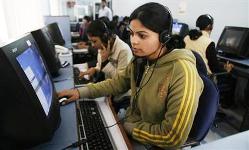 More needs to be done to boost women's and girl's lagging online access, tech giant Intel Corp said in a report to be released later on Thursday that calls for doubling the number of female Internet users in developing nations over the next three years.
More needs to be done to boost women's and girl's lagging online access, tech giant Intel Corp said in a report to be released later on Thursday that calls for doubling the number of female Internet users in developing nations over the next three years.
The report, funded by the global chipmaker with input from the United Nations and U.S. State Department, among others, points to stubborn gaps in women's access to the Internet in Africa, the Middle East and other developing parts of the world.
It found women are nearly 25 percent less likely than men to be online in those regions, and called on policymakers and technology companies to take steps such as making it easier to access the Internet on mobile phones, allowing free mobile content and boosting digital literacy to shrink the gap.
Surveys and interviews with more than 2,200 women and girls focused on four developing countries -- Egypt, India, Mexico and Uganda -- found that Internet access was critical for women to earn more money or search and apply for jobs.
"With the powerful capabilities the Internet enables -- to connect, to learn, to engage, to increase productivity, and to find opportunities -- women's lack of access is giving rise to a second digital divide, one where women and girls risk being left further and further behind," said Melanne Verveer, ambassador for global women's issues at the State Department.
Although the United States and other developed nations see fairly high levels of overall Internet access and usage among women, some gaps remain, mostly in rural areas or among the poor.
In the developing world, however, the gap is far wider.
Just 11 per cent of men and women in India have Internet access compared to 79 percent in the United States, said Shelly Esque, a vice president for the chipmaker and president of its educational foundation.
Thursday's report shows 600 million women in developing nations, or 21 percent, are online now, and another 450 million are expected to gain Internet access by 2016.
But taking extra steps could help bring an additional 150 million women and girls online over the next three years, the report said.
Good for global economy
Esque pointed to the role technology played in the Arab Spring revolts, particularly in Egypt.
"Information was such a powerful tool," she told Reuters. "What would be the potential for a country like that if they were able to have more equal access? We need to work on that."
A UN Human Rights Council resolution last year recognized the power of the Internet to spur progress and encouraged countries to promote and facilitate access to it.
Still, many women surveyed by Intel cited barriers ranging from the belief that Internet use was not "appropriate" for them to the cost of getting connected. Illiteracy and lack of awareness about potential uses also were factors.
Increased access would not only improve women's lives but also boost the global economy, according to Intel's report.
It would add between $50 billion and $70 billion in potential new market opportunities, the report said.
It could also bring another $13 billion to $18 billion each year globally to the market value of goods and services -- a measure known as gross domestic product or GDP.
The findings by the Santa Clara, California-based company aim to encourage other technology companies, policymakers and nongovernmental groups to take steps to get more women and girls online, it said.
"Without access to the Internet, women lack access to its tools, resources and opportunities," the report said.
"This gap disadvantages not just women, but their families, communities and countries."
Editing by Warren Strobel and Xavier Briand
Image: Employees at a call centre provide service support to customers in Siliguri | Photograph: Rupak De Chowdhuri/Reuters









 © 2025
© 2025